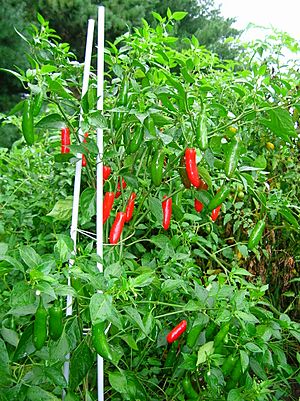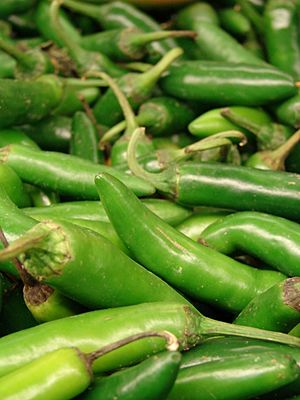Serrano pepper facts for kids
Quick facts for kids Serrano pepper |
|
|---|---|

Serrano pepper plant with red and green fruits
|
|
| Species | Capsicum annuum |
| Origin | Puebla and Hidalgo Mexico |
| Heat | |
| Scoville scale | 10,000–23,000 SHU |
The serrano pepper (Capsicum annuum) is a type of chili pepper. It first grew in the mountains of Mexico, specifically in the states of Puebla and Hidalgo. The name "serrano" comes from the Spanish word sierras, which means mountains.
About the Serrano Plant
Serrano pepper plants can grow quite tall, from about 1.5 to 5 feet (0.5 to 1.5 meters) high. Each plant can produce up to 50 peppers!
You can pick serrano peppers when they are green, or you can wait for them to ripen. When they are ripe, they can be green, red, brown, orange, or yellow. Serrano plants like warm weather, above 75°F (24°C), and they don't like frost at all. They also prefer soil that is not too acidic, with a pH between 7.0 and 8.5.
Serrano Peppers: Hot and Tasty!
Serrano peppers are known for being quite spicy! Their heat is measured on something called the Scoville scale. Serrano peppers usually score between 10,000 and 23,000 Scoville Heat Units. This means they are hotter than a jalapeño pepper.
People often eat serrano peppers raw because they have a fresh, strong, and spicy flavor. They are great for making popular Mexican dishes like pico de gallo and salsa. This is because the serrano pepper is quite "fleshy," meaning it has a good amount of pulp, which is perfect for these sauces.
The serrano pepper is the second most used chili pepper in Mexican cuisine. Many serrano peppers are grown in Mexico, especially in the states of Veracruz, Sinaloa, Nayarit, and Tamaulipas. These states produce around 180,000 tons of serranos every year!
See also
 In Spanish: Chile serrano para niños
In Spanish: Chile serrano para niños


